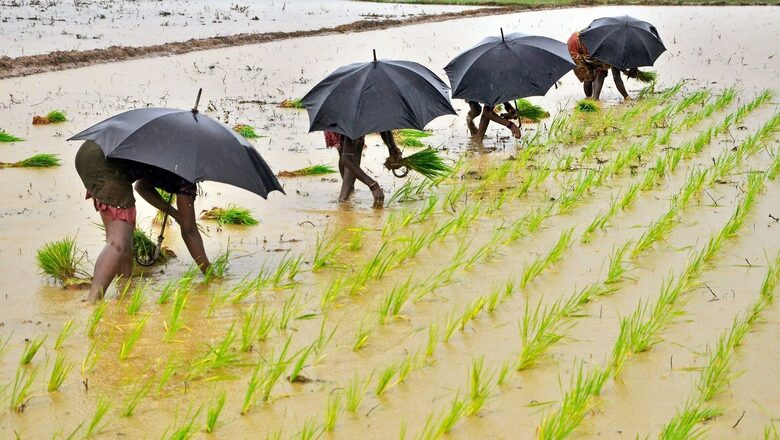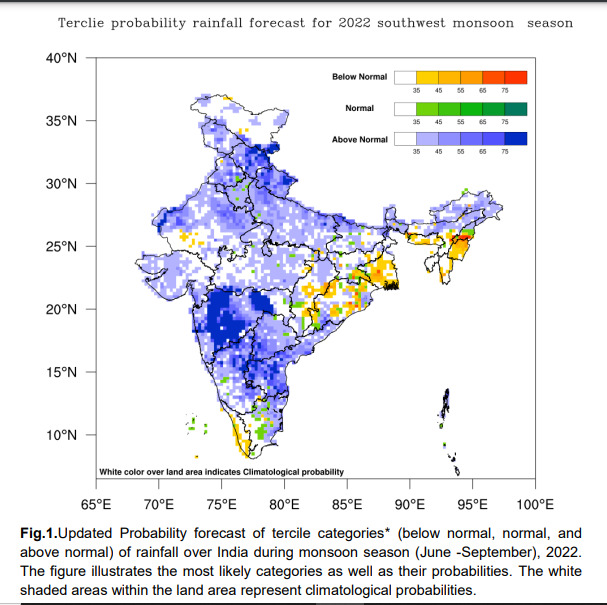
views
In a piece of good news, the southwest monsoon — which has already made an early onset over Kerala — is likely to bring above-normal rains for the key rain-fed agricultural states of the country. With share of agriculture to India’s Gross Domestic Product (GDP) at nearly 20% — highest in the last 17 years — the forecast instils confidence of a positive growth in the current fiscal.
According to India Meteorological Department (IMD), the overall rainfall over the country is expected to remain normal for the fourth consecutive year in a row. On Tuesday, the department further upped its rainfall forecast from 99% to 103% of LPA — the long period average is based on the average rainfall for the period from 1971-2020. The LPA was recently revised to 87 cm. The forecast carries a model error of ± 4%.
The good news is that Central India and southern peninsula could see excess rains to the tune of 106% of LPA. The likelihood of above normal rains is even higher for the core monsoon zone – stretching from Gujarat, Madhya Pradesh, Chhattisgarh, Jharkhand to Odisha – states which are most dependent on rains to sustain their farming activities.
There is a 62 per cent probability that the rainfall will be above normal or above normal, 19 per cent that it will be in excess, and 14 per cent of it being below normal. This augurs well for the country which receives nearly 75% of its total annual rainfall during the period of four months, starting June.

It is most crucial for the agricultural sector which is heavily dependent of the southwest monsoon to meet the water needs for Kharif crops sown during the season. A good monsoon will ensure that the farmers can go about with their plans of sowing regular crops, and hope for a good production.
Monsoon Progress
The scenario looks good so far. The ocean and atmospheric conditions are turning favourable. According to IMD, the moderate La Niña conditions — characterised by cooler sea-surface temperatures over equatorial Pacific — are prevailing so far. The latest global models forecast indicates that the La Niña conditions are likely to continue during the upcoming monsoon season, which positively impacts the monsoon.
After making its onset over Kerala three days in advance, the monsoon is now slowly advancing over the mainland, and is expected to cover the north-eastern states during the next 2-3 days. The models suggest, that the rainfall will remain normal or above normal over many parts of northwest & central India, northern parts of South Peninsula and some parts of east India.
Below normal rainfall is most likely over many parts of northeast India, some pockets of central & east India and southern parts of south peninsular India, subject to monsoon’s progress. However, the rainfall averaged over the country as a whole during June 2022 is most likely to be normal (92 to 108 % of LPA). The LPA of rainfall during June based on data of1971-2020 is about 165.4 mm.
The arrival of rains is closely tied to the sowing of Kharif crops which begins mid-June across most states, especially for those planting paddy, cotton and pulses. A good agricultural production will also give the necessary fillip to economic growth, which is highly dependent on agriculture, and boost consumer demand. The share of agriculture in GDP has increased to nearly 20%, with more than half of the population dependent on it for their livelihood.
This year’s Economic Survey indicated that the agriculture sector has experienced buoyed growth during the past two years. According to the latest provisional estimates released by the government, India’s GDP grew by 8.7% in 2021-22.
Geographical Distribution Critical
While the forecast brings cheer to the farmers, it may still be too early to celebrate. While the long-term forecast of the monsoon allays apprehensions of a sub-par monsoon, and a drought-like situation, it cannot predict the actual spatial distribution of rains, which is most crucial for farmers.
Over the years, the intra-season variabilities in the monsoon and erratic rains has left large parts of India struggling to meet their water requirements. The number of days of heavy rainfall are on rise which triggers concern. The active and break spells during June to September determine how the agricultural production might fare. This is better captured in the 15-day and 5-day forecast issued by the weather department especially for the farmers, enabling them to plan their crops, and irrigation facilities accordingly.
Nonetheless, the forecast inspires confidence.
Read all the Latest India News here


















Comments
0 comment